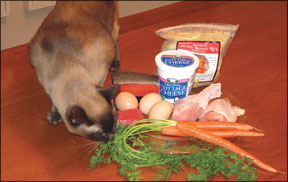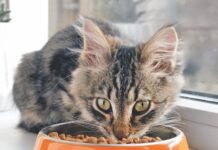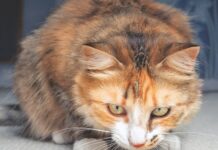In March 16, 2007, Menu Foods, Inc. initiated a recall of pet food processed at two of its facilities and sold under multiple brand names. By early April 2007, more than 40 cat food products were included in the recall. 288 As a result of this widespread recall of pet food, many pet owners are concerned with the safety of their cats food and have turned to their own kitchens for alternatives. “There has definitely been more interest in formulating homemade diets, considering that this recall has affected the entire industry and not just one company,” relates Joseph J. Wakshlag, DVM, PhD, assistant professor of clinical nutrition at Cornell University’s College of Veterinary Medicine. The demand for homemade diets has been so great that Internet users trying to request help with recipes nearly crashed the website of one veterinary nutritionist: The sheer numbers of pet owners and veterinarians attempting to access www.petdiets.com overwhelmed the system, relates Rebecca L. Remillard, PhD, DVM, who is board-certified by the American College of Veterinary Nutritionists (ACVN). “We were bombarded with requests,” she explains. “The web site started to crash and we had to move it to a larger server.” Are Homemade Diets the Answer? The renewed interest in homemade diets hinges largely on the assumption that if a cats diet is made entirely of fresh foods it wont eat contaminated food. Unfortunately, this is not necessarily true. The current pet food recall is thought to involve a contaminant (the investigation is still pending) that was found in a “food grade” product, explains Dr. Remillard. “Food grade” is fit for consumption by 

With this understanding, before a cat owner commits to switching from a high-quality commercial pet food to feeding a homemade diet, several additional aspects of fresh diets should be considered.
Cats are very different in their nutritional needs than other species, says Dr. Wakshlag, making it “much harder to develop a balanced diet for a cat than for a dog.” The biggest problem that Dr. Wakshlag sees with many homemade diets is that they simply arent balanced nutritionally. “You can create a lot of deficiencies,” he says, noting that taurine is a nutrient that is frequently deficient in homemade cat diets unless supplements are used.
Finding a recipe for a diet that contains all necessary nutrients can be difficult in itself, notes Dr. Remillard. Many recipes listed on the Internet or published in books are not created by veterinary nutritionists, she notes, and are not suitable for long-term feeding. Many recipes are actually designed as treats, not lifelong diets.
“In order to be balanced, a diet not only has to have all the necessary nutrients, it must also have these nutrients in the right amounts and in the correct relationships to each other,” points out Sean Delaney, DVM, an associate veterinarian and assistant clinical professor at the University of California-Davis School of Veterinary Medicine. “No one can look at a diet and determine if its balanced,” he says. It requires a much more complex analysis. Veterinary nutritionists can safely develop recipes for cats; however, these specialists number fewer than 50 in the United States – so access to their expertise is limited.
Since the most recent pet food recall, many general-practice veterinarians have contacted veterinary nutritionists and purchased one or two balanced recipes for pets to share with interested clients. Though balanced and complete, these diets may pose another prickly problem: The diet may be perfect, but only if the cat eats it.
“Cats have high nutritional requirements and eat small amounts of food,” explains Dr. Remillard. “When its necessary to add four to five supplements to such a small quantity of food, you have a choice. You can either pill the cat – which is never very pleasant – or you can put the supplements in the food.
“Cats are sensitive to flavors, and with the amount of supplements required in the food, you just cant hide the [unpleasant] taste,” she says. For this reason, Dr. Remillard recommends that clients use an all-in-one product developed specifically for cats: Balance IT Feline (available through www.balanceIT.com), which is more palatable and simpler to use.
The cats notorious tendency to be finicky is part of the reason why Dr. Delaney developed a complex computer program (available for use through www.balanceIT.com). This allows veterinarians and pet owners to create complete and balanced diets for cats using ingredients that the individual pet finds most appetizing. Want a diet that includes kittys favorites of salmon and sweet potato? Or maybe eggs and tapioca? No problem. Within seconds of plugging in your felines specific information and favorite temptations, the program will create a recipe that is completely balanced and suitable for a lifetime of meals. (Balance IT is currently offering a free recipe to all readers through July 31, 2007. Enter “homemade” when asked for a PROMO code on the website.)
Sticking to It
If youre interested in feeding a homemade diet, perhaps the biggest question is: Are you prepared for all that a fresh diet involves? Do you have the financial resources to offer your cat a homemade diet? The ingredients and supplements necessary for a homemade diet can cost six times as much (or more) as a commercially prepared diet. Then theres the time involved in shopping for, preparing and safely storing the meals. The owner becomes the person responsible for quality control and consistency, notes Dr. Remillard.
Storage can also be an issue for some pet owners. The diet ingredients will require refrigeration (or freezing), as will the prepared diet. Substitutions may be necessary if a particular item is unavailable on a particular day, and the pet owner will need to be knowledgeable as to which substitutions are acceptable and which are not.
And then theres the need for organization and a bit of foresight: Batches of meals will need to be prepared in advance if you plan on traveling and leaving your kitty home with a petsitter. Or, if you plan to take your cat traveling with you, youll need to figure out how to prepare the diet “on the road.”
Homemade or Commercial?
Theres no shame in feeding your feline a high-quality, commercially prepared diet, say the experts interviewed for this article. In fact, an excellent commercial diet is an assurance that your cat will receive the nutrition it needs. If, however, you want to offer your cat an alternative to processed foods by feeding a homemade diet, take these words to heart: “If youre going to feed a homemade diet, do it right,” says Dr. Wakshlag. Use only a recipe that has been developed by a veterinary nutritionist, and follow the recipe to the letter. If a cat is what it eats, you want to make sure that yours eats the very best.
v


